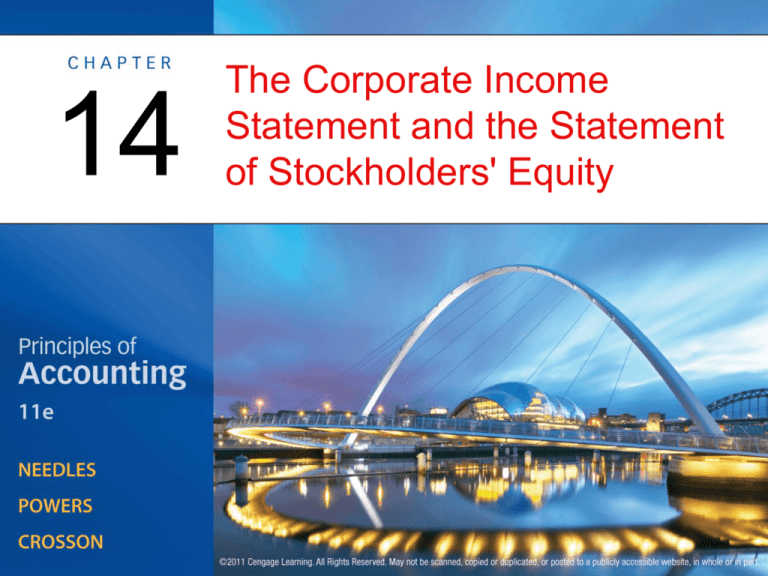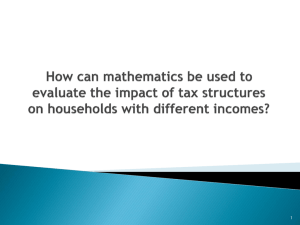
14
The Corporate Income
Statement and the Statement
of Stockholders' Equity
Performance Measurement: Quality of
Earnings Issues
OBJECTIVE 1: Define quality of earnings,
and identify the components of a corporate
income statement.
Exhibit 1: Corporate Income Statement
Performance Measurement: Quality of
Earnings Issues
• The most commonly used predictors of a
company’s performance are expected
changes in earnings per share and expected
return on equity.
– Net income is a key component of each of
these measures.
Performance Measurement: Quality of
Earnings Issues
• The most commonly used predictors of a
company’s performance are expected
changes in earnings per share and expected
return on equity. (cont.)
– Income from continuing operations is made up
of revenues, costs and expenses, gains and
losses from the sale of assets, write-downs of
assets, restructurings, and income taxes
expense on continuing operations.
Performance Measurement: Quality of
Earnings Issues
• The effect of accounting estimates and
methods
– For earnings per share and return on equity to
be valid, the quality of earnings must be good.
Performance Measurement: Quality of
Earnings Issues
• The effect of accounting estimates and
methods (cont.)
– The quality of earnings is affected by the
following:
• The accounting methods and estimates the
company’s management chooses
• Gains and losses reported in the operating section
• The existence of write-downs or restructurings
• The nature of nonoperating items
Performance Measurement: Quality of
Earnings Issues
• The effect of accounting estimates and
methods (cont.)
– The quality of earnings is affected by the
choice of one acceptable estimate, method, or
procedure over another.
– Uncollectible accounts—methods and
percentage estimate
Performance Measurement: Quality of
Earnings Issues
• The effect of accounting estimates and
methods (cont.)
– Inventory—methods and applications
– Depreciation of plant assets—methods,
estimates of life, and estimates of residual
value
– Depletion of natural resources—estimate of
life in tons, barrels, and so on
Performance Measurement: Quality of
Earnings Issues
• The effect of accounting estimates and
methods (cont.)
– Amortization of intangibles—difficulty in
estimating useful life
– In general, choosing the most conservative
figure produces the best quality of earnings.
Performance Measurement: Quality of
Earnings Issues
• Gains and losses
– It is best not to refer only to the bottom-line
figure.
Performance Measurement: Quality of
Earnings Issues
• Write-downs and restructuring
– A write-down is recorded when the value of an
asset drops below its carrying value.
– A restructuring is the estimated cost of altering
a company’s operations, often involving plant
closures and layoffs.
Performance Measurement: Quality of
Earnings Issues
• Write-downs and restructuring(cont.)
– Both write-downs and restructurings reduce
current operating income and are often an
indication of bad decisions having been made
by management.
Performance Measurement: Quality of
Earnings Issues
• Non-operating items
– Discontinued operations
– Extraordinary gains and losses
– Accounting changes
Performance Measurement: Quality of
Earnings Issues
• Non-operating items (cont.)
– Generally, gains and losses, asset write-downs,
restructurings, and nonoperating items have no
effect on cash flows; however, sustainable
earnings generally do have a relationship to
future cash flows.
– Quality of earnings is especially relevant to
considerations pertaining to return on assets
and return on equity.
©2011 Cengage Learning All Rights Reserved. May not be scanned, copied or duplicate, or posted to a publicly accessible website, in whole or in part.
Income Taxes
OBJECTIVE 2: Show the relationships among
income taxes expense, deferred income
taxes, and net of taxes.
Table 1: Tax Rate Schedule for
Corporations, 2008
Income Taxes
• Corporate taxable income and tax liability
– Corporate taxable income is determined by
subtracting allowable business deductions from
includable gross income.
– Tax rates currently range from a 15 percent to a
39 percent marginal rate.
Income Taxes
• Corporate taxable income and tax liability
(cont.)
– Computing income taxes for financial
reporting purposes differs from computing
income taxes due the government for the same
accounting period because financial reporting
income is governed by generally accepted
accounting principles, whereas taxable income
is governed by the Internal Revenue Code.
Income Taxes
• Because accounting income normally
differs from taxable income, income tax
allocation is usually necessary.
– Under income tax allocation method, the
difference between the current tax liability and
income taxes expense is debited or credited to
an account called Deferred Income Taxes.
Income Taxes
• Because accounting income normally
differs from taxable income, income tax
allocation is usually necessary. (cont.)
– Adjustments to this account must be made in
light of legislated changes in income tax laws
and regulations.
– The Deferred Income Taxes account can have a
debit balance (asset) or a credit balance
(liability).
Income Taxes
Income Taxes
• Certain income statement items must be
reported net of taxes.
©2011 Cengage Learning All Rights Reserved. May not be scanned, copied or duplicate, or posted to a publicly accessible website, in whole or in part.
Earnings per Share
OBJECTIVE 3: Compute earnings per share.
Key Ratios
• Basic earnings per share
• Diluted earnings per share
Exhibit 2: Motorola's Earnings Per Share
Presentation
Earnings per Share
• An earnings per share figure is a measure
of performance that can be composed of
several parts.
– A simple capital structure requires only one
earnings per share figure.
– A complex capital structure requires both a
basic earnings per share figure and a diluted
earnings per share figure.
Earnings per Share
• Potentially dilutive securities and their
application to earnings per share.
– Stock options and convertible preferred stocks
or bonds have the potential to dilute earnings
per share.
– A stockholder’s proportionate share of
ownership could be reduced, so presentation of
both basic earnings per share and diluted
earnings per share is required.
Earnings per Share
• Potentially dilutive securities and their
application to earnings per share. (cont.)
– Diluted earnings per share are calculated by
adding all potentially dilutive securities to the
denominator of the basic earnings per share
calculation.
©2011 Cengage Learning All Rights Reserved. May not be scanned, copied or duplicate, or posted to a publicly accessible website, in whole or in part.
Comprehensive Income and the Statement
of Stockholders’ Equity
OBJECTIVE 4: Define comprehensive
income, and describe the statement of
stockholders’ equity.
Exhibit 3: eBay's Statement of
Comprehensive Income
Exhibit 4: Statement of Stockholders’
Equity
Exhibit 5: Stockholders’ Equity Section of
a Balance Sheet
Comprehensive Income and the Statement
of Stockholders’ Equity
• Corporate income statements should
present comprehensive income.
• A statement of stockholders’ equity is a
labeled computation of the changes in
stockholders’ equity accounts during the
period.
Comprehensive Income and the Statement
of Stockholders’ Equity
• It reveals everything that is in a statement
of retained earnings and is also a summary
of the period’s stock transactions.
• Ordinarily, Retained Earnings shows a
credit balance. However, when a debit
balance exists, the corporation is said to
have a deficit.
©2011 Cengage Learning All Rights Reserved. May not be scanned, copied or duplicate, or posted to a publicly accessible website, in whole or in part.
Stock Dividends and Stock Splits
OBJECTIVE 5: Account for stock dividends
and stock splits.
Stock Dividends and Stock Splits
• A stock dividend is the proportional
distribution of additional stock to a
corporation’s present shareholders.
– It conserves cash.
– It tends to lower the stock’s market price.
– It allows for a nontaxable distribution.
Stock Dividends and Stock Splits
• A stock dividend is the proportional
distribution of additional stock to a
corporation’s present shareholders.
– It increases the company’s permanent capital
by transferring a portion of retained earnings to
contributed capital.
– Journalize the declaration and distribution of a
small and a large stock dividend.
• Observe stockholders’ equity before and after the
dividend.
Stock Dividends and Stock Splits
Stock Dividends and Stock Splits
• A stock split is a distribution of additional
stock for the purpose of effecting a decline
in market price.
– Par or stated value decreases.
– At most, a memorandum entry is needed.
Stock Dividends and Stock Splits
©2011 Cengage Learning All Rights Reserved. May not be scanned, copied or duplicate, or posted to a publicly accessible website, in whole or in part.
Book Value
OBJECTIVE 6: Calculate book value per
share.
Book Value
• Book value per share when there is no
preferred stock.
Book Value
• Book value per share when there is
preferred stock.
– The call value is deducted from stockholders’
equity in the numerator.
– Dividends in arrears are also deducted.
©2011 Cengage Learning All Rights Reserved. May not be scanned, copied or duplicate, or posted to a publicly accessible website, in whole or in part.








